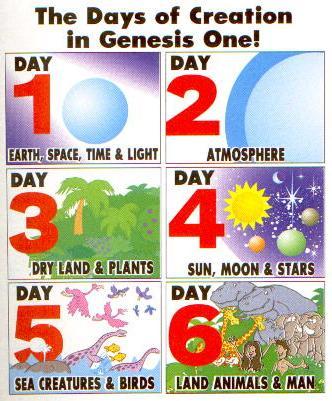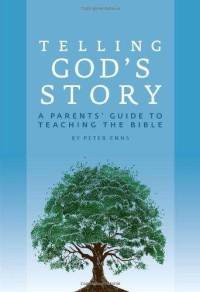The subtitle of chapter 3 is "The three stages of teaching the Bible: elementary, middle grades, and high school."
The Elementary Years: Knowing Jesus - Who He was, What He did, What He said
The author contends that in the very young years of the child, our goal shouldn't be to teach them the
Bible but to introduce them to Jesus who is the main purpose of the Bible.
"Jesus is the focal point of the Christian Bible. This doesn't mean we have to 'find Jesus' in every verse of the Old Testament. Rather, the Bible as a whole is going somewhere, and that 'somewhere' is actually a 'someone.' The Bible doesn't exist to talk about itself. It exists to reveal who God is, what he has done, and who we are as a result. The absolute center of all this is Jesus..."
Enns points out that the early church preached Jesus to both the Jews and Gentiles; though the Jews had strong background in the Old Testament writings, the Gentiles did not. Even so, the apostles did not first acquaint the gentiles with the OT but preached Jesus first.
"...Jesus was proclaimed to the Jews as their Messiah...and to the Gentiles as their Lord, a term that had definite political overtones at the time...That proclamation was accompanied by all sorts of miracles...(and) was also demonstrated, very visibly, by the qualities of character that appeared in Jesus' earliest followers: joyful willingness to suffer and die for Jesus' sake...; self-sacrifice for others; generosity; forgiveness..."

The early church got straight to the point.
"The point of Scripture is ultimately to introduce people to Jesus. His is what makes the Christian faith unique; not moral teaching, nor Bible stories, but a man who was also God...We hope for our children to know this Jesus - not to develop an encyclopedic knowledge of the Bible..."
Enns points out that we should follow Jesus' own example of how He handled children, which was with warmth, comfort, acceptance, blessing.
"In the early grades we should focus on bringing out the full portrait of Jesus. What should not be emphasized is the child's miserable state of sin and the need for a savior." The author's reason for de-emphasizing the issue of sin at this age is that young children want so badly to please parents that they will often make a "profession of faith" because they know this is what the parent is looking for.
"We must remember that our children's salvation is not our work, it is the work of the Spirit."
The Middle-Grade Years: Getting a Big Picture of the Bible
In grades 5-8 the goal should be to place Jesus, who your child has been introduced to, into the larger context of the whole of Scripture. Starting with Jesus first gives coherence to the Bible because it helps the child understand that there is one overarching purpose to all that is recorded in scripture, which is Jesus. To use Enns' analogy of the messy bedroom and how to bring order to it, you could say that Jesus is the closet. He is the
"grand organizing space within which we, as Christians, understand all of the Bible." And now in the middle grade years, your child will gain some strong and important hanging hooks to put in the closet.
The middle-grade child will learn the big story of God and His people. They should learn the basic flow of the biblical story (such as the timeline and overview of Israel's history - the small beginnings with one family and its growth; Israel's tribal existence and eventual enslavement in Egypt; Moses' leadership out of bondage and their wilderness wanderings; Joshua's conquests; the major kings of Israel; their fragmentation and subsequent dispersion and exile and finally their subjection to superpowers (Persia, Greece, and Rome). All of this leads to the time of Jesus.
"When students of the Bible learn to control this basic outline of Israel's history, many important hooks and hangers will be added to their closet organizer. They should also begin to get a feel for the different genres - or literary styles - of the Bible...The middle-grade years are the 'hook and hanger' stage, providing students with the most important 'pegs' in the biblical story on which to hang more detailed knowledge as they grow."
Grades 9-12: Understanding the Bible in its Settings
In this section Enns introduces ideas about the Bible that could be controversial to those of us who have been raised to think of it through a particular 20th century western evangelical lens. He presents the idea that the Bible is an ancient text and that
"Genesis 1 has elements in common with creation stories of the ancient world - and those creations stories are older than the Bible. The same goes for the Flood story...The Bible seems to fit quite well in this ancient world - perhaps a little too well. As we study, the Bible can begin to look less unique; less like God's word."
Israel's laws look similar to other ancient law codes; portions of Proverbs and Job are similar to wisdom literature of Mesopotamian and Egyptian texts, etc. Because of these realities, it can thereby be easy for a young person, sitting in a secular classroom and hearing these things, to assume along with the instructor, that the Bible is simply one of many ancient texts. And if those other texts aren't true, then the Bible must not be true either.
It's important that we present the true nature and purpose of the Bible to our children so that they can understand that just because it is not entirely unique does NOT mean it is not God's Word. In this respect, we should return to the author's starting point in the previous chapter:
Jesus and the Bible are similar. "In the same way that we would not expect Jesus to be alien in his culture, we should not expect the Bible to be alien in its culture(s)."
The fact that the Bible has similarities with the ancient cultures in which it was written is NOT a strike against our faith, and the way we can challenge that mistaken idea is to study how the Bible fits into those cultures. As we do this, we get a better notion of what our God is like
who, in His wisdom, chose to give us His word in a way that fits so well into the cultures in which it was written.
There are things in the Bible that can be fleshed out and clarified by the documents from the ancient world.
"Generations of discoveries from the ancient Mesopotamian world have shed invaluable light on how these stories (in Genesis) are meant to be understood." Israel's laws, wisdom literature, temples, priests, sacrifices, prophets, kings all have counterparts in other cultures older even than Israel.
"This is the Bible we have...Study of the Bible's composition and its context will not present an obstacle to faith; but it will challenge and deepen faith, even as it nudges us out of our comfort zones."
Next chapter (4): "Traditional Approaches: Drawbacks and Misunderstandings"
 A second theological lesson we get from Genesis 1 is that the creation story shows God making order out of chaos, putting everything into its place. In days 1-3 God brings form out of formlessness; in days 4-6 He makes things to fill the void/emptiness of the form of the first 3 days.
A second theological lesson we get from Genesis 1 is that the creation story shows God making order out of chaos, putting everything into its place. In days 1-3 God brings form out of formlessness; in days 4-6 He makes things to fill the void/emptiness of the form of the first 3 days.



